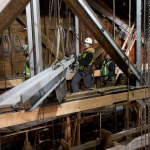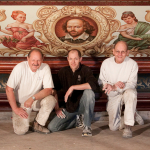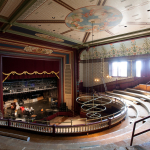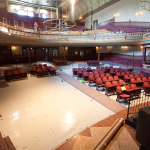-
Early Years
 The Grand Opera House opened its doors on August 9, 1883 with the production of 'The Bohemian Girl' by the C.D. Hess Opera House Company. William Waters, a local architect, was chosen to design the new opera house. Waters had designed over 100 buildings in Oshkosh, including the public library and museum. Theatergoers experienced lavish and modern Victorian design, from the hand-painted drop curtain to the elaborately detailed wall and ceiling artistry of local artist J. Frank Waldo. Roman influences, evident in the huge curved ceiling beams and columns rising up on either side of the proscenium, combined with the Queen Anne style in the auditorium, reflected the opulence of the era. Although the official capacity of the new theater was 921, additional chairs could comfortably accommodate crowds of more than 1,000 people. 'Jump seats,' which folded out from the walls and from the ends of the seats, brought the total possible seating capacity to 1,224.
The Grand Opera House opened its doors on August 9, 1883 with the production of 'The Bohemian Girl' by the C.D. Hess Opera House Company. William Waters, a local architect, was chosen to design the new opera house. Waters had designed over 100 buildings in Oshkosh, including the public library and museum. Theatergoers experienced lavish and modern Victorian design, from the hand-painted drop curtain to the elaborately detailed wall and ceiling artistry of local artist J. Frank Waldo. Roman influences, evident in the huge curved ceiling beams and columns rising up on either side of the proscenium, combined with the Queen Anne style in the auditorium, reflected the opulence of the era. Although the official capacity of the new theater was 921, additional chairs could comfortably accommodate crowds of more than 1,000 people. 'Jump seats,' which folded out from the walls and from the ends of the seats, brought the total possible seating capacity to 1,224.
The new theater attracted acts from around the country, from Grand Opera to Broadway Musicals and, in the 1920s, Vaudeville. The unique acoustic quality of the hall, which some had said to rival that of the huge Mormon Tabernacle in Salt Lake City, brought considerable fame to Oshkosh. Vincent Price, Harry Blackstone, John Phillip Sousa, Harry Houdini, Sarah Bernhardt, Maude Adams, Celeste Holm, and President William Howard Taft were among the performers who performed at the Grand Opera House. In more recent years, The Smothers Brothers, Debbie Reynolds, and most recently, Jeff Daniels have graced The Grand's stage.
In 1918, the opera house was purchased by W.G. Maxcy and W.D. Cummings. In the late 1920s, Mrs. Isabel Maxcy, widow of the previous owner, took over the theater and it was closed for several months for remodeling and redecorating. Improvements included modern heating and ventilation, lighting and plumbing systems. Mrs. Maxcy sold the opera house, then known as the Granada, to Sol Winoker for $40,000 in 1948. Winoker changed the name to Civic Theater and reopened it as a motion picture house.
In 1950, the building was renamed the Grand Theater by the new owners Frank Bluhm and Mary Vetter. In order to achieve the appearance of a modern movie theater, the building's entrance was moved from the center of the façade to the corner of Market Street and High Ave. and nearly eight feet of the stage apron was removed to make room for additional seats. In 1969, F.J. Hauser and L.L. Cook bought the Grand Theater. They replaced the old coal furnace and the roof. In the mid 1970s, two men from Rockford, Illinois, William Seaton and Maurice Goldy leased the building from Hauser. Seaton, with the help from others, removed the plaster coverings that had covered the original features of the Grand's interior.
Local citizens, headed by James and Joanne Alderson, were concerned about the building, which was falling into disrepair, and formed a committee titled 'Save the Grand.' This committee had the building placed on both the state and the national historic registers.
Back
-
Renovations and Reopening
The First Renovation - 'Save the Grand'
 The fight to ‘Save the Grand’ lasted 20 years and faced numerous financial, civic and organizational obstacles. Finally, in 1980, citizens requested that a referendum be offered to city residents regarding the destiny of the building. The referendum was approved by the Common Council. Two-thirds of Oshkosh voters replied ‘yes’ to the referendum question on whether or not the City of Oshkosh should acquire, restore and engage in the operation of the Grand Opera House.
The fight to ‘Save the Grand’ lasted 20 years and faced numerous financial, civic and organizational obstacles. Finally, in 1980, citizens requested that a referendum be offered to city residents regarding the destiny of the building. The referendum was approved by the Common Council. Two-thirds of Oshkosh voters replied ‘yes’ to the referendum question on whether or not the City of Oshkosh should acquire, restore and engage in the operation of the Grand Opera House.
On October 4, 1982, the marquee-breaking ceremony marked the official start of the restoration project. The first year was spent clearing the building of debris from the past four decades and raze the unsafe areas. In addition, the adjacent property at 106 High Avenue, which dates from the same period as The Grand, was purchased and connected to the theater. This addition provided space for restrooms, a greater lobby area and street-level access for the handicapped, as well as a meeting room and administrative offices on the second floor. It is in fact now the main entrance to the complex.
When the building was finally ready for reconstruction, only the proscenium and the balcony remained. The interior was then rebuilt from the basement up. The sympathetic restoration was meticulously carried out in an effort to have a facility that is as much like the original as possible, while using modern materials and architectural knowledge and conforming to current building codes.Reopening

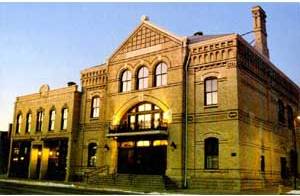 The newly renovated opera house hosted its reopening dedication and open house on September 27, 1986. After nearly four years and expenditures of approximately $3.5 million the building’s restoration was complete. On October 3, 1986, the new Grand Opera House opened its doors the same way it had over a century before, with a newly-staged performance of “The Bohemian Girl.”
The newly renovated opera house hosted its reopening dedication and open house on September 27, 1986. After nearly four years and expenditures of approximately $3.5 million the building’s restoration was complete. On October 3, 1986, the new Grand Opera House opened its doors the same way it had over a century before, with a newly-staged performance of “The Bohemian Girl.”
At its reopening in 1986, Grand Opera House was set up as a rental hall and operated as a unit of the city of Oshkosh’s Parks Department. The classification of The Grand as a rental hall prevented its management from promoting the theater or scheduling performances directly. The greatest problem for the management was finding enough presenters who could afford to bring their performances to the opera house and successfully market their events.
In 1989, a proposal was offered by the Oshkosh Opera House Foundation to change the Grand Opera House from a rental hall to a combination presenting/rental hall, like most other theaters in the United States. Despite some opposition, the plan was accepted and the Oshkosh Opera House Foundation took over the management of The Grand leasing the building from the city in November of 1989.Second Restoration - 'Stand with the Grand'

In the process of evaluating the structure to prepare for installation of a new fire sprinkler system, engineers discovered some structural flaws in the main roof trusses of the opera house—structural elements from the 1883 construction. After weeks of evaluation, these structural issues were discovered to be compromising to the integrity of the building, and the City of Oshkosh, owners, ordered The Grand closed for emergency repair on February 27, 2009. Faced with half a performance season and no venue, the Oshkosh Opera House Foundation proceeded to move over twenty-five scheduled performances to seven alternate venues, over the next four months. The first of these relocated shows was moved that very day from The Grand to the Alberta Kimball Civic Auditorium on four hours notice, and opened on that very night, across town, only a half-hour late. From March-June, the structural issues were investigated and were determined to include not only the roof trusses, but the attic ceiling joists and plaster ceiling as well. The Opera House Foundation worked with representatives of the City of Oshkosh, assisted by the Oshkosh Landmarks Commission and Wisconsin State Historical Society, developed a plan for reconstruction of the structural elements while maintaining the decorative and historic features of the theater. The price for repair and restoration was just under $2 million.
The issue of funding the repair became a political one at that time, as city councilors debated whether or not to fund repair, citing economic difficulties and in some cases, philosophical differences. The Opera House Foundation, along with support from key local businesses and service organizations, began a campaign to generate community support and to bring it to the forefront, before the key vote was taken. The movement, known as the “Stand With the Grand” movement, galvanized the community, as children donated their allowances and lawn mowing money in collection boxes, and businesses and individuals pledged a “Grand for the Grand”.
The Opera House Foundation coordinated this support and, with the concept of adding a restoration fee to future ticket purchases, pledged up to $250,000 over the succeeding ten years, to be generated from these ticket charges and community pledges.
On August 25, 2009, the issue came to a climax, as several hundred people rallied in the parking lot of the Oshkosh City Hall prior to the scheduled City Council meeting, singing, chanting, and encouraging councilors to vote in favor of the repair funding. An overflow crowd packed the council chambers and adjacent rooms, and for three hours, over fifty citizens ranging from middle school to senior citizens, spoke passionately to the councilors about what The Grand meant to them and to their families. As the evening ended, what had previously appeared to be a highly contested vote resulted in an unanimous decision in favor of funding the Grand Opera House repair and restoration.
The second restoration of The Grand Opera House began in the fall of 2009. In an unique public/private partnership, city staff and Grand Opera House staff worked side by side with the contractors and engineers, with Opera House staff paying particular attention to the artistic and decorative elements and to restoring The Grand to its prior beauty. On September 16, 2010, The Grand was re-opened to a gala opening-night crowd, as actor/singer/songwriter Jeff Daniels provided an evening of laughter and tears. Daniels followed with an encore performance the next day open to the general public, and the Opera House Foundation followed with a week of open house free performances, to thank the community and the taxpayers for their support.
-
The Historic Grand Opera House Today
 The Grand has a current seating capacity of 550 that re-creates the warm, intimate atmosphere of a European-style theater while showcasing some of the best talent today. The Grand Oshkosh hosts nearly 125 public performances each year including national touring artists; educational programs; performances by the Oshkosh Community Players and Oshkosh Symphony Orchestra; as well as performances by four area high schools, regional arts groups, performances presented by independent promoters, business meetings and weddings. The theater's impact is felt not only in Oshkosh, but also in surrounding communities.
The Grand has a current seating capacity of 550 that re-creates the warm, intimate atmosphere of a European-style theater while showcasing some of the best talent today. The Grand Oshkosh hosts nearly 125 public performances each year including national touring artists; educational programs; performances by the Oshkosh Community Players and Oshkosh Symphony Orchestra; as well as performances by four area high schools, regional arts groups, performances presented by independent promoters, business meetings and weddings. The theater's impact is felt not only in Oshkosh, but also in surrounding communities.


